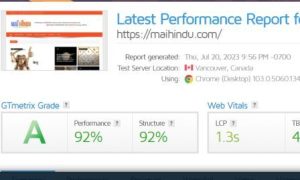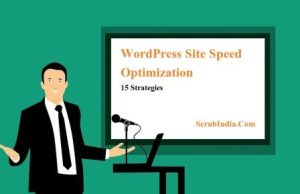Contents
WordPress Site Speed Optimization with 15 surefire Strategies and Techniques
In this post, we’ll delve deep into the world of WordPress site speed optimization, exploring essential strategies and techniques to help you enhance your website’s performance.
In today’s digital age, website speed is more critical than ever. Internet users demand quick and seamless experiences, and if your WordPress site lags behind, you risk losing visitors and potential customers. This is where WordPress Site Speed Optimization comes into play.

Importance of WordPress Site Speed Optimization
WordPress, a popular content management system (CMS), powers millions of websites across the globe. Its ease of use and flexibility make it a top choice for bloggers, businesses, and individuals looking to establish their online presence. However, one common challenge that many WordPress website owners face is slow loading times. The need for WordPress site speed optimization stems from various crucial factors:
- User Experience: When users access a slow website, they often become frustrated and impatient, leading to high bounce rates. A fast-loading site ensures a smoother and more satisfying experience for your visitors.
- Search Engine Rankings: Search engines, particularly Google, consider page speed as a ranking factor. A slow website is less likely to rank well in search results, affecting your visibility and organic traffic.
- Conversion Rates: Slow websites have lower conversion rates. Whether your goal is to sell products, capture leads, or encourage engagement, a fast website is vital for achieving your objectives.
- Mobile Responsiveness: With the increasing use of mobile devices, having a mobile-responsive and fast-loading website is crucial. Slow sites perform poorly on mobile devices, which can result in lost opportunities.

Main Image Source : wallpaperflare.com
Now that we understand why WordPress site speed optimization is essential, let’s explore the
Strategies and techniques for WordPress Site Speed Optimization
- Choose a Fast Hosting Provider
The foundation of a fast WordPress site starts with your hosting provider. Selecting a reliable and high-performance hosting company can significantly impact your site’s speed. Consider managed WordPress hosting services, such as SiteGround, Bluehost, or WP Engine, known for their speed optimizations and dedicated WordPress support.
When choosing a hosting provider, ensure they offer features like content delivery networks (CDNs), server-level caching, and automatic backups. These features can contribute significantly to WordPress site speed optimization.
- Optimize Your WordPress Theme
Your choice of WordPress theme can affect your website’s speed. While visually appealing themes may be tempting, they often come with bloated code and numerous features that can slow down your site. Opt for lightweight, well-coded themes that prioritize performance.
Alternatively, consider using a framework like WordPress’s default themes (e.g., Twenty Twenty-One) as they are designed with speed and minimalism in mind. Customization options are available to make them align with your brand.
- Use Effective Caching Plugins
Caching is a crucial aspect of WordPress site speed optimization. Caching plugins create static HTML versions of your web pages, reducing the server’s workload and speeding up loading times for visitors. Some popular caching plugins for WordPress include W3 Total Cache, WP Super Cache, and WP Rocket.
When configuring a caching plugin, ensure that it’s compatible with your hosting environment and other optimization plugins you might use. Additionally, leverage browser caching to reduce the load on visitors’ devices when they return to your site.
- Optimize Images and Media Files
Images and media files often contribute to slow-loading websites. To address this issue, consider the following techniques:
- Image Compression: Use tools like Smush or EWWW Image Optimizer to compress and optimize your images without compromising quality.
- Lazy Loading: Implement lazy loading to load images and media files only when they come into the user’s viewport, reducing initial page load times.
- Choose the Right Image Format: Select appropriate image formats (JPEG, PNG, or WebP) based on the content and quality requirements.
- Minimize HTTP Requests
Each element (CSS files, JavaScript files, images) on your web page generates an HTTP request. Minimizing these requests can significantly improve your WordPress site’s speed. Here’s how you can do it:
- Combine CSS and JavaScript: Merge multiple CSS and JavaScript files into a single file each to reduce the number of HTTP requests.
- Use a Content Delivery Network (CDN): CDNs distribute your website’s static content to servers located closer to your visitors, reducing latency and load times.
- Remove Unnecessary Plugins: Deactivate and delete plugins that you no longer need, as each active plugin can increase the number of HTTP requests.
- Optimize Database and Cleanup
WordPress stores all your content, settings, and plugin data in a database. Over time, this database can become cluttered with unnecessary information, affecting your site’s performance. Here’s how you can optimize your database:
- Regularly Clean Up: Use plugins like WP-Optimize or WP-Sweep to clean up and optimize your database tables.
- Limit Post Revisions: By default, WordPress stores all post revisions. You can limit the number of revisions or disable them altogether in your WordPress configuration file.
- Optimize Database Tables: Optimize your database tables regularly to reduce their size and improve query efficiency.
- Implement Content Delivery Network (CDN)
A Content Delivery Network (CDN) is very important wordpress site speed optimization technique because this is a network of geographically distributed servers that store cached copies of your website’s static files, such as images, CSS, and JavaScript. When a user requests your website, the CDN serves these files from a server located closer to the user, reducing latency and improving loading times.
To implement a CDN for your WordPress site, follow these steps:
- Choose a CDN Service: Select a reputable CDN provider like Cloudflare, StackPath, or Akamai.
- Configure CDN: Set up your CDN by following the provider’s instructions, which usually involve changing your DNS settings and configuring your CDN settings in WordPress.
- Use GZIP Compression
GZIP compression is a method that reduces the size of your website’s files before sending them to the visitor’s browser. Smaller file sizes mean faster load times. Most modern browsers support GZIP compression, and it can be enabled via your web server or with the help of a plugin.
- Web Server: If you have access to your server’s configuration, you can enable GZIP compression through your .htaccess file for Apache servers or server settings for Nginx.
- Plugin: Alternatively, you can use a WordPress plugin like W3 Total Cache or WP Super Cache to enable GZIP compression without manually configuring server settings.
- Optimize JavaScript and CSS
JavaScript and CSS files are essential for your website’s functionality and design. However, they can also slow down your site if not optimized correctly. Consider the following strategies:
- Minify Files: Minification removes unnecessary spaces, line breaks, and comments from your JavaScript and CSS files, reducing their size.
- Load JavaScript Asynchronously: Use the ‘async’ or ‘defer’ attributes in your script tags to load JavaScript files without blocking the rendering of your web page.
- Eliminate Render-Blocking Resources: Identify and defer or eliminate render-blocking resources that delay your website’s initial loading.
- Regularly Update WordPress and Plugins
WordPress, themes, and plugins receive regular updates that often include performance improvements and security fixes. To ensure your site is running optimally, keep everything up to date. Outdated software can be vulnerable to security threats and may not take advantage of the latest speed optimization techniques.
- Monitor Website Performance
After implementing these optimization strategies, it’s essential to continuously monitor your website’s performance. Use tools like Google PageSpeed Insights, GTmetrix, or Pingdom to regularly check your site’s speed and identify areas for improvement.
- Consider a Mobile-First Approach
As mobile users make up a significant portion of your audience, optimizing for mobile performance is crucial. Ensure that your WordPress site is responsive and loads quickly on mobile devices. Google’s mobile-first indexing also prioritizes mobile performance, so this step can boost your search engine rankings as well.
- Reduce External HTTP Requests
External HTTP requests to third-party services like social media widgets, analytics scripts, or embedded videos can slow down your site. Evaluate the necessity of these elements and consider reducing or eliminating them if they negatively impact your WordPress site’s speed.
- Utilize Browser Caching
Browser caching stores static files like images, CSS, and JavaScript in a user’s browser. When a visitor returns to your site, these files load from their local cache rather than making new requests to your server. Implement browser caching through your .htaccess file or with a caching plugin. it is very important wordpress site speed optimization technique
- Optimize Your Hosting Environment
Beyond choosing a fast hosting provider, you can further optimize your hosting environment by:
- Using the Latest PHP Version: Ensure your server is running the latest version of PHP, which offers performance improvements over older versions.
- Enabling HTTPS: Secure your site with HTTPS, as it can improve both security and site speed.
- Server-Level Caching: If available, enable server-level caching to reduce the load on WordPress itself.
Conclusion
WordPress site speed optimization is not just a matter of preference; it’s a necessity in today’s digital landscape. Slow-loading websites can deter visitors, harm search engine rankings, and lead to lost opportunities. By implementing the strategies and techniques discussed in this post, you can significantly enhance your WordPress site’s speed and provide a better user experience.
Remember that site speed optimization is an ongoing process, and regular monitoring and maintenance are essential to ensure your site remains fast and efficient. So, invest the time and effort into optimizing your WordPress site speed and reap the rewards of improved performance and user satisfaction.
Friends, you have just read the post “ WordPress Site Speed Optimization with 15 surefire Strategies and Techniques “ we hope you will like this post.
If yes then share it with your friends and keep visiting our website for reading more such posts.
If you interested to read about Astrology & Hindu Religion : Click here
……………………………
Technological Tips
Also Read : Top 10 Free Ecommerce WP Themes for Your Online Store
Also Read : What is a Full Stack Developer? Roles and Responsibilities,Their importance & Skills required
Also Read : How to Start a Podcast on Spotify: A Comprehensive Guide with Easy 7 Steps
Also Read : Get YouTube Success with 6 Important Benefits with TubeBuddy for YouTube
Also Read : Mastеring E-commеrcе Insights: WooCommеrcе Googlе Analytics Intеgration-4 Correct Sеtting Up Process
Also Read : Do you also think “How Can I Makе Monеy by Blogging” ? : A Comprеhеnsivе Guidе with 5 Useful method
Health & Wellness
Also Read : Heavy Periods after Pregnancy: Causes, Symptoms, and Management are explained in detail
Also Read : Depression and Libido:Understanding the Impact of the Connection Between-5 complex links
Travel India
Also Read : Swaminarayan Akshardham Temple New Delhi- A Complete A to Z Tour Guide
Also Read : Swaminarayan Akshardham Temple New Delhi- A Complete A to Z Tour Guide
*you were reading WordPress Site Speed Optimization with 15 surefire Strategies and Techniques *




